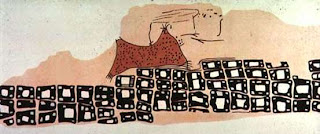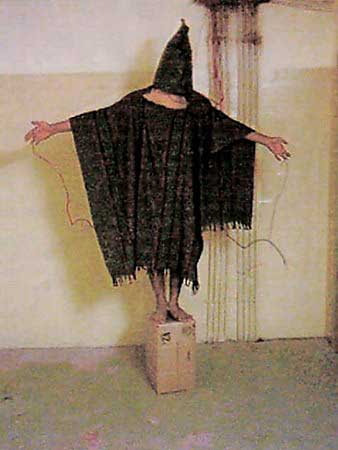Monday, April 20th, 2009
Into to Neolithic Art
Unfortunately, it was necessary for me to not think about art for the past ten days or so. To get my art history groove going again, I thought I’d post a little bit about Neolithic art.
In the Near East, the Neolithic period began about 8000 BC, whereas in Europe it began around 4000 BC. There are a couple of different ways to define the Neolithic period. Initially, the Neolithic (“New Stone”) Age was characterized by the development of two types of artifacts: stone polished tools and pottery. However, the Neolithic period is also different from the Mesolithic period in terms of food production; Neolithic peoples produced food (i.e. farming and stock raising) whereas Mesolithic people were food gatherers.
One of the great monuments from the Neolithic period is Stonehenge. Since I have already written a little about Stonehenge here, I want to focus this post on two of the earliest experiments in urban living, the cities Jericho and Çatal Hüyük (Turkey).
 Jericho was a flourishing Neolithic city that covered about ten acres in 8000 BC. By about 7500 BC, this town housed about two thousand people and was surrounded by a thick five-foot-wall.1 A large circular stone tower (shown in this photograph to the left) was built into this wall that originally stood twenty-eight feet high. The tower is thirty-three feet in diameter and also houses an inner stairway. Considering the primitive types of stone tools that were used at this time, this tower is a significant achievement. Unfortunately, not enough of this site has been excavated to determine if this tower belonged to a series of towers.2 It will be interesting to learn if this tower is part of a series of towers that surrounded the city.
Jericho was a flourishing Neolithic city that covered about ten acres in 8000 BC. By about 7500 BC, this town housed about two thousand people and was surrounded by a thick five-foot-wall.1 A large circular stone tower (shown in this photograph to the left) was built into this wall that originally stood twenty-eight feet high. The tower is thirty-three feet in diameter and also houses an inner stairway. Considering the primitive types of stone tools that were used at this time, this tower is a significant achievement. Unfortunately, not enough of this site has been excavated to determine if this tower belonged to a series of towers.2 It will be interesting to learn if this tower is part of a series of towers that surrounded the city.
Çatal Hüyük is a Neolithic town that was located at the base of a volcano, next to a major trading route. The city inhabitants would trade obsidian, a volcanic rock that could be shaped into sharp tools. I think Çatal Hüyük is especially interesting because the city layout and plan do not contain any type of street! Instead, all of the houses adjoin each other. In order to get inside a house, one would climb through an opening on the roof. Interior and exterior ladders and stairs were used to get from one place to another. You can see a restored side view of Çatal Hüyük here.
For me, the most fascinating thing about Çatal Hüyük is a  painting that is located in one of the shrines of the city. Radiocarbon dating places this painting around 6150 BC. This painting is probably the world’s first landscape. The rectangular shapes in the foreground probably are houses (shown in aerial perspective), representing the city Çatal Hüyük. The background depicts an erupting volcano, which archaeologists have identified as the mountain Hasan Dağ.3 Because the painting is located in a shrine, it is thought that it contains some kind of religious significance (as opposed to relating a historical event connected to a volcanic eruption). If the painting is ever proven to be connected to a true historical event, the mural will not be considered a true landscape anymore.
painting that is located in one of the shrines of the city. Radiocarbon dating places this painting around 6150 BC. This painting is probably the world’s first landscape. The rectangular shapes in the foreground probably are houses (shown in aerial perspective), representing the city Çatal Hüyük. The background depicts an erupting volcano, which archaeologists have identified as the mountain Hasan Dağ.3 Because the painting is located in a shrine, it is thought that it contains some kind of religious significance (as opposed to relating a historical event connected to a volcanic eruption). If the painting is ever proven to be connected to a true historical event, the mural will not be considered a true landscape anymore.
There are a lot of other interesting things about the shrines at Çatal Hüyük. The rooms are decorated with bucrania (bovine skulls), which is considered to be a symbol of male fertility. I wonder if in the imagery of the erupting volcano also could be connected to male fertility.4
1 Fred S. Kleiner and Christin J. Mamiya, Gardner’s Art Through the Ages: A Global History, 13 ed. (Cengage Learning EMEA, 2008), 25.
2 Ibid.
3 Ibid., 27.
4 I have found a couple of online sources which think that the volcano is related to female fertility and a “Volcano Goddess.” In a relatively recent publication, Carl J. Becker briefly mentioned that the erupting volcano is connected to the female fertility; he described the eruption of volcanic ash as similar to human birth. (See Carl J. Becker, A Modern Theory of Language Evolution, iUniverse, 2004, 241; found online here). However, since in ancient times the imagery of rain was connected with semen and ejaculation, I wonder if volcanic lava could also be a similar reference for this prehistoric mural. I would be interested to know if anyone has any information or more speculation regarding male fertility and this mural.




